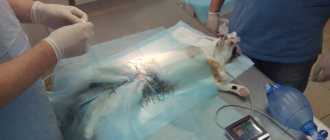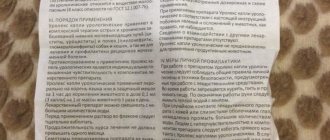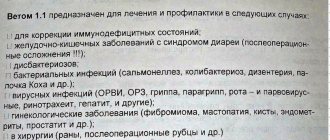6761Pavel
7
Dexamethasone is a medicine of a number of steroid hormones, intended for the treatment of people, but it is often prescribed to dogs and other animals, and the instructions for using the drug Dexamethasone for cats must be strictly followed. Since this drug is hormonal and replaces cortisol in the body, its use has a significant impact on the functioning of the endocrine system, which means that it is unacceptable to use it uncontrollably or “preemptively”, this causes harm to the animal’s body. However, the wide spectrum of action of the drug makes it indispensable in the treatment of eczema, conjunctivitis, otitis media, allergies and other diseases. Sold in veterinary and medical pharmacies.
Indications for use
global $ads_google;
//data-ad-slot=”2475549904″ $ads_google = empty($ads_google) ? false : true; ?> if ($ads_google == false) {?> $ads_google = true; ?> } ?> If you read the instructions, it becomes clear why the tool is so popular. The medicine can be used if the cat has:
- bursitis;
- arthritis;
- intervertebral hernia;
- pathology of the musculoskeletal system;
- eczema;
- allergic dermatitis;
- bronchial asthma;
- lupus erythematosus;
- leukemia;
- allergies to medications;
- cancer;
- anaphylactic shock;
- Quincke's edema;
- injuries and swelling after injuries.
As you can see, it makes sense to keep several ampoules in your veterinary kit.
Dexamethasone is prescribed to cats if their adrenal glands do not secrete certain hormones. When a cat begins to have eye problems, such as conjunctivitis, keratitis, blepharitis or keratoconjunctivitis, they purchase the product in the form of eye drops. They act as an anti-inflammatory medicine for diseases of the organs of vision of non-infectious origin.
Contraindications and side effects
If Dexamethasone is given to a cat in ampoules according to the instructions, then no side effects should occur. But there are still several contraindications for use:
- problems with the gastrointestinal tract;
- hormonal imbalance in the body;
- poor eyesight;
- heart problems;
- allergy to one of the components of the drug;
- diabetes.
Dosage form of the drug
It is also prohibited to use eye drops for viral or fungal infections. And since it is impossible to independently determine the presence of a particular disease, it is necessary to seek advice from a specialist.
Release form and composition
On the shelf in the veterinary pharmacy there is Dexamethasone, represented by eye drops, tablets, injection and ointment. All these forms are designed for ease of use and disease specificity.
The most popular are injections. In addition to the main active ingredient, the composition contains boric acid, sodium tetraborate decahydrate, water for injection and other components.
Characteristics of the drug Dexamethasone
Dexamethasone is manufactured in the Netherlands by Alfasan International BV. The drug is intended for humans, but is also suitable for treating cats. The main condition for the effective use of a medicine is the correct calculation of the dosage and regimen of use. Dexamethasone is often prescribed in the presence of inflammatory processes in the animal’s body. It also helps fight poisoning and allergy symptoms.
Pharmacological properties
Dexamethasone is a substitute for the natural hormone cortisol, secreted by the adrenal cortex.
Cortisol plays an important role in many physiological processes as it affects muscles and joints. In addition, this hormone ensures the normal functioning of the endocrine and nervous systems. Therefore, its deficiency in the animal’s body can lead to the development of a number of diseases.
The anti-inflammatory property of the drug is due to the fact that in the animal’s body this hormone stops the production of substances responsible for the development of inflammation. Dexamethasone also suppresses some receptors, due to which the body stops responding to irritants. As a result, allergic reactions stop.
Injections act faster, so they are more often used in cases of shock and injury to animals.
Composition and release form
The drug is available in the form of eye drops, tablets, injections and ointments. This allows you to choose the best option depending on the diagnosis given to the specialists. Injections are most often used to treat cats.
The composition of the drug includes:
- dexamethasone sodium phosphate (active substance);
- boric acid;
- sodium tetraborate decahydrate;
- disodium edetate dihydrate;
- benzalkonium chloride;
- water for injections.
Instructions for use of Dexamethasone
The instructions describe all cases of use of the drug and recommendations for its use. The dosage is selected according to the pathological process, general health, and symptoms.
The drug Dexamethasone is most often recommended for use in combination with other medications. This enhances the effect and speeds up the healing process of the purr. Combine the product with:
- Aspirin;
- Rimadyl;
- Phenobarbital;
- Insulin;
- Mitotane;
- Cyclosporine;
- Amphotericin;
- Cyclophosphamide;
- Digoxin.
Despite all the information received, you should not take everything into your own hands and treat your beloved cat without examining a doctor.
A visit to the veterinarian is also required to ensure that the right combination of medications is selected that will treat your pet without undesirable consequences. In case of unforeseen complications or reactions, the doctor prescribes an analogue of the drug or cancels the previously prescribed one.
Injections
All organisms are unique, so the dosage is selected individually. It is important to take into account the cat’s body weight and its disease. If it is anaphylactic shock, then only one injection is needed. For 1 kg of body weight you need to take 1.5 ml of Dexamethasone injection.
In other cases, it is recommended to take an average of 0.5 to 1.5 ml of medication per 1 kg of weight. The administration is intramuscular, so if you have no experience, you should study the information on how to give an intramuscular injection to a cat.
Eye drops
Unfortunately, our pets are not protected from diseases of the organs of vision, so the veterinarian may recommend buying Dexamethasone eye drops. If the course of the disease is acute, then drop 3-5 times a day, 1 drop per eye. Treatment takes place within 48 hours.
global $ads_google; //data-ad-slot=”2475549904″ $ads_google = empty($ads_google) ? false : true; ?> if ($ads_google == false) {?>
$ads_google = true; ?> } ?>
If the disease is chronic, apply one drop to each eye twice a day.
On average, treatment lasts up to three weeks, but this will be determined by your veterinarian. It happens that a cat develops problems with the retina or develops strabismus. In these cases, it is advisable to start using drops 6-7 days after surgery, this will reduce the likelihood of developing inflammation.
Dexamethosone is dripped 3-4 times a day for a course of 2-4 weeks.
Pills
Dexamethasone tablets are rarely prescribed to treat cats. There are understandable reasons for this. The product in tablet form acts slowly compared to injections, and not every cat is happy to swallow a tablet.
However, you can and should learn to give your animal a pill.
If long-term treatment is prescribed, then preference is given to tablets
The dosage is recommended based on the pet’s weight; per 1 kg of body weight there should be 0.1 mg of dexamethosone.
Description of the drug
As we already said in the introduction, Dexamethasone is a drug that was originally invented specifically for humans and is sold in human pharmacies.
However, since the bodies of humans and animals have many similarities, it is also suitable for treating our pets. This drug is a complete analogue of the hormone cortisol, which is produced naturally in living beings. This drug has a depressing effect on the immune system, as a result of which the combination of biological substances that provoke the development of inflammatory processes is prevented. The drug works great as a remedy whose action is directed against:
- allergies;
- inflammation, etc.
Dexamethasone is an effective drug
This drug is released in the form of:
- solution for subcutaneous administration;
- eye drops;
- tablets, etc.
In liquid form, the drug has a transparent color, provided that you purchase it in an injection format. You can buy ampoules with a volume of 50 and 10 milliliters.
The spectrum of action of this product is really wide, as is the scope of its application. Thus, in veterinary practice it can be used not only in the treatment of cats, but also dogs and other animals.
During their lives, cats suffer many ailments, which Dexamethasone can cure.
Indications for the use of the drug can include various diseases in cats, for example:
- various pathologies of the adrenal glands;
- rheumatoid type arthritis;
- various pathologies of the animal’s nervous system;
- arthrosis;
- ailments associated with damage to the lungs and respiratory tract;
- lupus erythematosus;
- skin diseases;
- ailments associated with disruption of the gastrointestinal tract;
- anaphylactic shock;
- traumatic shock, etc.
However, it is important to remember that the drug, as we have already said, is highly effective and strong, so you need to use it with caution if your cat has:
- pathologies of the heart and circulatory system of the body;
- kidney failure;
- liver failure;
- diseases of the digestive system;
- diseases of the endocrine system;
- disturbances in the functioning of the visual organs.
Selecting the correct dose of Dexamethasone that a cat needs in a given situation will determine whether the treatment will have negative consequences
It is extremely important for the veterinarian to know how to choose the correct dose of the drug, and for this he needs to have a good understanding of what result he expects. The fact is that it is strictly forbidden to prescribe Dexamethasone as a “just in case” remedy. The fact is that even in small quantities this hormone provokes an imbalance in the endocrine system.
If cats have allergies or any inflammatory processes requiring intervention, Dexamethasone is prescribed to animals in the form of:
- injections;
- tablets;
- less drops.
The product is sold in any human pharmacy, including veterinary
It is worth saying that the effect of Dexamethasone, for comparison, is several times more effective than the effects of such drugs as:
- "Cortisone";
- "Prednisolone", etc.
Provided that the cat does not take the medicine pointwise (not by dripping into the eyes, for example), all systems of its body receive some part of the incoming substance. This drug itself rarely acts as the main drug, but it almost always becomes an element of complex therapy for diseases such as:
- inflammation of the conjunctiva of the eye;
- eczema;
- otitis, etc.
Dexamethasone is great for treating conjunctivitis in cats
In the article I will consider the conditions for prescribing the hormonal drug dexamethasone for cats. I will list the indications, contraindications and possible side effects of the medicine on pets. I will tell you about the features of use and dosages of the medicine in veterinary medicine. I will consider the price segment for the drug and its analogues.
Dexamethasone comes in three forms:
- Tablet form;
- Drops;
- Injection.
Eye drops 0.1% dexamethasone
Compound:
- Methyl parahydroxybenzoate;
- Sodium phosphate;
- Sodium metabisulfite;
- Propyl parahydroxybenzoate;
- Water.
The solutions are packaged in glass ampoules and bottles of 50 and 100 ml and are a clear, odorless liquid. The tablets are packaged in foil bags of 10 pieces. The product is packaged in a cardboard box marked with the date of manufacture and supplied with instructions for use.
Dexamethasone drops and solution are not interchangeable.
The drug belongs to the hormonal-steroid type. Initially designed for use in the treatment of humans, but can be used in the treatment of animals.
The drug is used only in agreement with a veterinarian and under his strict supervision.
The medicine is prescribed by a veterinarian when diagnosing diseases:
- Arthritis;
- Arthrosis;
- Rheumatism;
- Anaphylactic or post-traumatic shock;
- Allergic reaction;
- Lupus erythematosus;
- Dermatitis;
- Otitis;
- Conjunctivitis.
We invite you to read: Instructions for use of the drug tylosin in veterinary medicine
Dexamethasone has anti-inflammatory, desensitizing, antiallergic, antishock and antitoxic properties
A one-time administration will reduce the symptoms of allergies, anaphylactic shock, swelling from bites of poisonous insects and reptiles.
Uniqueness
The drug dexamethasone is unique in its immediate effect on the body's cells at any stage of the inflammatory process.
The drug controls and stabilizes cell function in a minimum period of time
Dexamethasone is an analogue of the drug prednisolone, but unlike it:
- Does not retain water and sodium in the body;
- Minimizes the removal of calcium and potassium from the body;
- Suppresses the activity of vitamins D.
The drug should be used with great caution, as it is a hormonal type. Exact adherence to the dosage and rules of administration will have a beneficial effect on the pet’s body.
The drug is used as follows:
- Injections. Type of administration – intravenous, subcutaneous and intramuscular. The solution temperature should be at room temperature. The required dose is drawn into a disposable sterile syringe and administered in a convenient way. Before the injection, the injection site is disinfected with alcohol, and after the injection, it is distributed with massage movements to avoid the formation of bumps and bruises. The standard injection course will be from 5 to 7 days, but the first injection must be given directly by a veterinarian.
- Pills. Not used for treating pets.
- Drops. Used to treat ophthalmic diseases. A drop solution at room temperature is instilled into the pet's eyes, after washing the eye area. The duration of treatment is no more than two weeks. Frequency of use 3-5 times a day.
The dosage of the solution is calculated individually for each pet. The calculation occurs in the proportion of 0.1-1.0 ml. per 1 kg of pet weight.
Conjunctivitis in a kitten
Drops are used 2 drops for each eye. 1 ml drops is equivalent to 1 mg. Dexamethasone.
Only a veterinarian can calculate the exact dosage. The first use of the medicine on a pet should be done by the same person, since if an allergic reaction occurs, the pet may require urgent qualified help.
The drug is mostly tolerated by cats and dogs without side effects, however in individual cases the following may occur:
- Convulsive contraction of the muscles of the limbs;
- Increased appetite;
- Lethargy;
- Increased intraocular pressure;
- Vomiting and nausea;
- Diarrhea;
- Dyspnea;
- Decreased level of immune defense against viruses and infectious diseases;
- Enuresis.
The drug is prohibited for use in pets:
- With hypersensitivity to the components of the drug;
- In the last trimester of pregnancy and during breastfeeding;
- Presence of parasitic diseases.
The use of dexamethasone is contraindicated in animals with hypersensitivity to the components of the drug
With caution and under the supervision of a veterinarian, it is possible to use for the following diseases:
- Of cardio-vascular system;
- Ophthalmic diseases;
- Liver failure;
- Gastrointestinal tract;
- Endocrine system.
The drug is stored in the manufacturer's packaging, closed. Storage location: dry, at room temperature, out of reach of children, away from direct exposure to ultraviolet rays.
The drug should be stored out of the reach of children, avoiding direct sunlight on the packaging.
Shelf life – 5 years from the date of manufacture. The solution, after opening the ampoule, is good for 24 hours if stored in a sterile, closed syringe in the refrigerator.
Price and analogues
The cost of the drug: for a solution in ampoules will be from 150 rubles for 25 pieces, drops - from 35 rubles per bottle.
Analogs of the drug in the form of drops:
- Maxidex;
- Pharmadex;
- Medexol;
- Dexapos;
- Dexacort.
Similar solutions for injections:
- Decadron;
- Dexamed;
- Fortecortin;
- Dexaven;
- Dexamethasone Vial.
The drug dexamethasone is as effective as it requires caution, dosage accuracy and regularity of use.
The owner of a cat and dog is responsible for his life and health. Therefore, the owner’s awareness of the disease and taking the drug, as well as regular visits to the veterinary clinic can contribute to a speedy recovery of the pet.
Used to correct the inflammatory response; antiallergic, antishock agent
Object of application: dogs, cats, rodents, birds
Dosage form: tablets, injections
Where to buy: medical or veterinary pharmacies
Available forms: 0.25 mg, 0.75 mg, 1 mg, 1.5 mg, 2 mg, 4 mg and 6 mg tablets. Ampoules 4 mg.
Dexamethasone is a corticosteroid known as a glucocorticoid. Corticosteroids are designed to replace the natural hormone produced in the adrenal cortex, cortisol. Corticosteroids act as a depressant on the immune system, blocking the synthesis of substances that cause inflammatory and immune reactions in the body. In case of immunodeficiencies and infections, treatment with dexamethasone should be carried out with caution.
Where and how to inject Dexamethasone
The Dexamethosone injection requires compliance with several simple rules. First, the intended injection site is examined; the skin should be healthy. No processing needed.
You cannot mix different drugs in one syringe!
The exact dose will be determined by the veterinarian; approximately 0.1-0.5 ml is taken.
Contraindications
The veterinarian should first of all find out from the owners whether the cat is currently being given any other medicine, since not all of them are compatible with each other.
The product is contraindicated for pregnant and lactating cats, as well as for cats before and after vaccination.
You will have to act more carefully if the cat has kidney and liver failure, or diseases of the cardiovascular system.
If the pet is elderly or has diabetes, the drug is prescribed in rare cases.
How to use Dexamethasone correctly?
This powerful corticosteroid drug must be prescribed by a veterinarian. It is administered to domestic animals once intramuscularly. A single dosage ranges from 0.1 to 1 ml, depending on the severity of the disease. The duration of therapy is also determined by the veterinarian.
If the next dose of Dexomethasone is missed, it should be administered as soon as possible. The following should be entered on a regular schedule. You cannot inject two doses of the drug at once.
The instructions warn about the possibility of developing side effects and reactions after using the medicine. Most often, this is an increase in the animal’s appetite and thirst, increased convulsive activity, increased urination, shortness of breath, diarrhea, vomiting, and lethargy.
The advisability of using this drug should be discussed with a veterinarian if the cat has the following problems: hypertension, diabetes, Cushing's syndrome, osteoporosis, chronic heart failure, kidney disease, intestinal ulcers. In decompensated forms of cardiac cachexia, the administration of Dexamethasone may be justified to reduce the effect of cytokines and to stimulate appetite.
This medicine is not prescribed for pregnant cats. Be sure to tell your veterinarian about the medications your animal is already taking. Perhaps Dexamethasone is incompatible with them.
So, this steroid drug is quite strong. It has many limitations in use and side effects. Therefore, it can be administered to a sick animal only as prescribed by a veterinarian and under his supervision.
The information posted on this page is for informational purposes only and cannot be used for self-medication! Before using medications, consultation with a specialist is MANDATORY!
These drops contain a synthetic glucocorticosteroid - dexamethasone, which is an analogue of one of the hormones of the adrenal cortex of mammals. This active substance is a powerful anti-inflammatory and antiallergic agent. It promotes the narrowing of small blood vessels, due to which phenomena that accompany many pathological processes, such as swelling and redness, disappear.
Dexamethasone in the form of eye drops quickly penetrates the superficial layers of the cornea, sclera and conjunctiva of the eye. The therapeutic concentration of the drug also accumulates in the moist environment of the surface of the eyeball. In this case, the presence of any damage to the eye tissue leads to an increase in the rate of penetration of the drug. The duration of action of this product is from 4 to 8 hours. A small amount of dexamethasone is absorbed into the blood of animals.
Veterinarians prescribe such drops to animals for the treatment of non-purulent conjunctivitis and blepharitis. This drug is also indicated for keratitis, scleritis, uveitis, iridocyclitis, chorioretinitis. Often the medicine is prescribed if the animal has various injuries to the cornea (in cases where the wound has already healed). These drops relieve allergic processes in the eye area. They are used for preventive purposes after various eye surgeries.
For whom: for mammals.
Dispensing form: this medicinal product is available in the form of a solution, packaged in special dropper bottles of 10 ml or 5 ml. Each 1 ml of the drug contains 1 mg of active substance.
Dosage: the drug must be instilled into animals, 1 drop 3-5 times a day. The duration of treatment can range from 1-2 days to 2 weeks. This depends on the nature and severity of the pathological process. First, you should remove all pathological discharge from the animal’s eye using saline, then gently pull back the lower eyelid and drip the medicine into the fold of the mucous membrane (preferably closer to the inner corner of the eye). The instilled medicine should not be too cold.
Limitations: contraindications to the use of this glucocorticosteroid are fungal, viral and purulent bacterial infections of the eyes, as well as allergic reactions in the animal to this drug. Using this medication without a veterinarian's prescription may result in a recurrence of some chronic eye conditions and many side effects.
Analogs
If there is a reason not to use Dexamethasone for cats, then analogues are purchased. They have a very similar principle of action, but it is better to choose a remedy together with a veterinarian.
| A drug | Photo | Price, rubles | Release form |
| Maxidex | №12 | 220-250 | drops |
| Pharmadex | №13 | 185-210 | drops |
| Medexol | №14 | 120-130 | drops |
| Dexafort | №15 | 1420 | suspension for injection |
| Fortecortin | №16 | 90-100 | injections |











